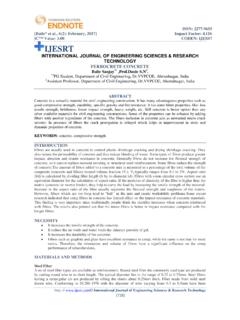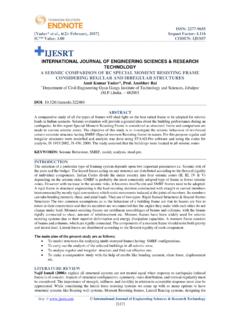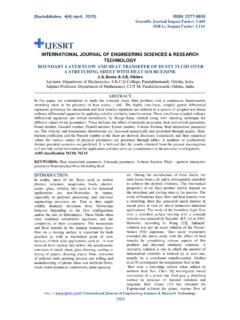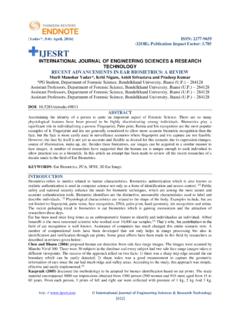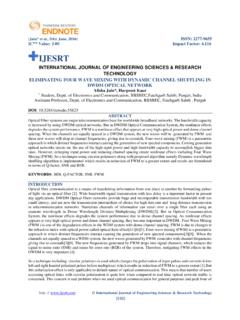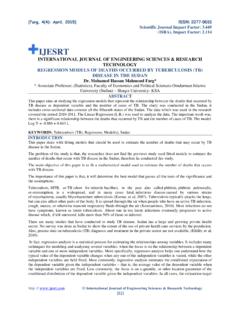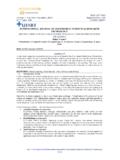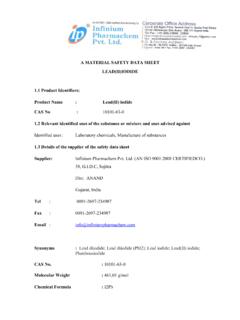Transcription of IJESRT
1 [Umbarov, 4(12): December, 2015] ISSN: 2277-9655 (I2OR), Publication Impact Factor: http: // International Journal of Engineering Sciences & Research Technology [530] IJESRT INTERNATIONAL JOURNAL OF ENGINEERING SCIENCES & RESEARCH TECHNOLOGY INVESTIGATION MECHANISMS AND KINETICS OF OXIDATION IODIDE IONS IN HYDROTHERMAL WATERS VARIOUS OXIDANTS Ibragim A. Umbarov*, Hayit K. Turaev * Termez State University, Termez, Uzbekistan ABSTRACT The paper studies oxidation mechanism and kinetics of iodide ions in hydrothermal waters in various oxidants. Physico-chemical studies of technologic extraction of iodine from underground water containing iodine combinations. KEYWORDS: hydrothermal water, iodinated water, absorbent, desorption, oxidant. INTRODUCTION Iodine is essential for human health. In Uzbekistan, an acute shortage of iodine is reflected primarily in the production activity of "Uzfarmximzavod" and "Uzzoovetsnab" The annual demand of the two organizations in the crystalline iodine brand "A" GOST 4159-79 - 10 tons, potassium iodide grade "A" - 2 2 tons, 5% iodine tincture - 10 tons [1-4].
2 At the same time, Uzbekistan is rich enough iodine contained in hydrothermal waters free of oil, mainly in Surkhandarya, Fergana, Bukhara-Karshi Artesian Basins and the Ustyurt plateau. [5] In these subterranean, salty waters contain enough iodine for industrial extraction. Therefore, the development of the technology of its extraction remains relevant theoretical and practical problems [6]. MATERIALS AND METHODS To study the mechanism and kinetics studies of iodide ions oxidation in hydrothermal waters of various oxidants in Surkhandarya artesian basin field Haudag were selected following oxidants: Na2S2O8, NaNO2, Н2O2, Са(ClO)2. For the process of iodine extraction from the iodine-containing brines underground water we carried out physico-chemical studies to assess the oxidative properties of the various reagents and on the kinetics and the degree of oxidation of iodine.
3 For the oxidation of various compounds of iodine in iodine-containing hydrothermal treatment were chosen above oxidants. RESULTS AND DISCUSSION The experimental data for use as oxidant Na2S2O8 iodine compounds in the test water are shown in Figure 1. Figure 1. Effect of Na2S2O8 amount of oxidant on the extraction of iodine from the studied water. As can be seen from Figure 1. in an acidic environment to completely oxidize compounds of iodine in 50 ml of water under study requires ml of 2 % solution of Na2S2O8. Further there were studied oxidative properties of NaNO2, to oxidize iodine compounds. The experimental data are shown in Figure 2. In this case, complete oxidation of compounds of iodine in 50 ml of water under study requires to 2% 0,4ml NaNO2. At the same concentration of Na2S2O8 solution and NaNO2, the latter is a strong oxidant.
4 [Umbarov, 4(12): December, 2015] ISSN: 2277-9655 (I2OR), Publication Impact Factor: http: // International Journal of Engineering Sciences & Research Technology [531] Figure 2. Influence of the amount of oxidant NaNO2 on the extraction of iodine from the studied waters. Further there were studied oxidative properties of H2O2 for oxidation of iodine compounds. The experimental data are shown in figure 3. Figure 3. Effect of the amount of oxidant H2O2 to extract iodine from the studied waters. It was established, that for the complete oxidation of iodine compounds in 50 ml of water under study there required ml of 5% H2O2. It is known, in the literature, as the oxidant of hypochlorite - ions titrate iodide at a pH of about 8 in the presence of starch [1]. This reaction takes place: 3ОСl- + I- IO3- + 3Сl- ( 1 ) We also applied as an oxidant calcium hypochlorite.
5 From the literature it is known that the oxidation of iodide hypochlorite is slower than the oxidation with chlorine, but with the rapid mixing of the reactants, it comes with a very high speed [1-3]. The buffer solutions containing a significant amount of chloride, hypochlorite oxidizes iodide to elemental iodine at pH 1-8 and a temperature of 20-50 C: ОСl- + I- IO- + Сl- (2) IO-+ I- +2H+ I2 + H2O (3) Concentrations of 2 10-4g-eq / l of the hydrogen ions present in the buffer solution is sufficient to maintain the reaction. The complete oxidation of chloride solutions J- hypochlorite occurs at a pH below 3,25-3,5 limit value of pH slightly higher than the oxidation with chlorine. With increasing pH the maximum degree of oxidation of iodide is decreased. Results of experiments with the use of calcium hypochlorite as the oxidant iodine compounds are shown in Figure 4.
6 Figure 4. Effect of the amount of oxidant Ca (ClO)2 on the removal of iodine from the study treatment. As follows from Figure 3 and 4, the application of higher concentrations of oxidizing agents, the yield of elemental iodine drops, but not as much as in the oxidation of chlorine water and the flow of oxidizer at the maximum degree of oxidation less than the results obtained on the pilot plant by oxidation by chlorine. Reducing the reaction time and improves the yield of oxidation of elemental iodine (from 94 to 97%) and reduces the consumption of oxidant, but not as much as in the oxidation of chlorine water. Our results of experiments showed that complete oxidation of iodine from the iodine-containing compounds studied water is required: 0,4-0,45 ml of Ca (ClO)2 (Figure 4). A slight increase in the concentration of the oxidizing agent reduces the concentration of iodine, which is associated with the transition of iodine from iodide forms iodates.
7 To obtain data on the kinetics of the oxidation of iodide ions in the presence of sodium nitrite, calcium hypochlorite and hydrogen peroxide oxidation was carried out with 50 ml of water model solutions with initial concentration of iodide ions mg / l at 20 C with various ratios of oxidants. The amounts of oxidized iodide ion was determined by extracting the formed molecular iodine in chloroform phase and determine it by sodium thiosulfate titration following the procedure described in the literature [4]. The received data held in Figure 5,6,7. Analysis of these data shows that the highest rate of oxidation of iodide ions is observed in the case of hydrogen peroxide (15-20 min), and sodium nitrite (20-25 min) and calcium hypochlorite (25-30 min). The change in the concentration of oxidants has almost no influence on the rate of oxidation reaction.
8 Considering that the reaction rate is increased 2-4 times when the temperature rises for every 10 C at 70 C [4] (the temperature of the raw water) oxidation reaction tested for minutes, at the top end portion desorption column. [Umbarov, 4(12): December, 2015] ISSN: 2277-9655 (I2OR), Publication Impact Factor: http: // International Journal of Engineering Sciences & Research Technology [532] Figure 5. The kinetics of oxidation of iodide ions in aqueous solutions in the presence of 2% NaNO2. NaNO2 ml volume: 1-0,6; 2-0,8; 3-1,0; 4-1,2. Figure 6. The kinetics of the oxidation of iodide ions in aqueous solutions in the presence of 2% Ca (ClO)2. The amount of Ca (ClO)2 ml: 1-1; 2-2; 3-3; 4-4 Figure 7. The kinetics of the oxidation of iodide ions in aqueous solutions in the presence of 5% H2O2.
9 The amount of H2O2 ml: 1-0,2; 2-0,4; 3-0,6; 4-0,8 CONCLUSION For the oxidation of iodine compounds in the studied water as oxidants tested were sodium persulfate, sodium nitrite, calcium hypochlorite and hydrogen peroxide. Calcium hypochlorite and hydrogen peroxide is proposed to oxidize iodine compounds in the test waters. A study of the oxidation of iodine ions shows the possibility of the complete extraction of iodine from industrial facilities. These data also show considerable speeding oxidation of iodide ion relative to the speed of the oxidation reaction of molecular iodine to iodates, resulting in desorption of molecular iodine in the air phase passes adequately (to 94%). REFERENCES [1] S. Ishanxodjayev, I. Umbarov, M. Mengturayev, Kulmatov, Study of iodine ions oxidation with potentiometric method , Uzbek Chemical Journal, , 2000, pp.
10 72-74. [2] I. Umbarov, Smirnova, S. Ishankhodjayev, Spectrometric methods of Iodite and Iodate Ions , Uzbek Chemistry Journal, , 2001, pp. 15-18. [3] Potayenko, Kulmatov, I. Umbarov, N. Y. Turayev, S. Ishankhodjayev, Iodine extraction technology from saline underground waters with air desorption method. , Uzbek Chemistry Journal, No. 5-6, 1999, pp. 92-95. [4] K. D. Potayenko, Kulmatov, I. Umbarov, N. Y. Turayev, Iodine extraction technology from drill waters with air desorption method. , Uzbek Chemistry Journal, No. 5-6, 1999, pp. 96-99. [5] K. D. Potayenko, I. A. Umbarov,. R. A. Kulmatov, Iodine extraction technology from underground thermal waters with air desorption method. , 3rd International Conference INNOVATION-00, 2000, pp. 143-144 [6] I. A. Umbarov, A. Mamatraimov, S. Himmatov, Study of Iodine Distribution in Natural Sources , Actual Problems in Analytical Chemistry, Abstract, Proceedings of 4th Republican Research-to-Practice Conference, Termez, 2014, pp.
